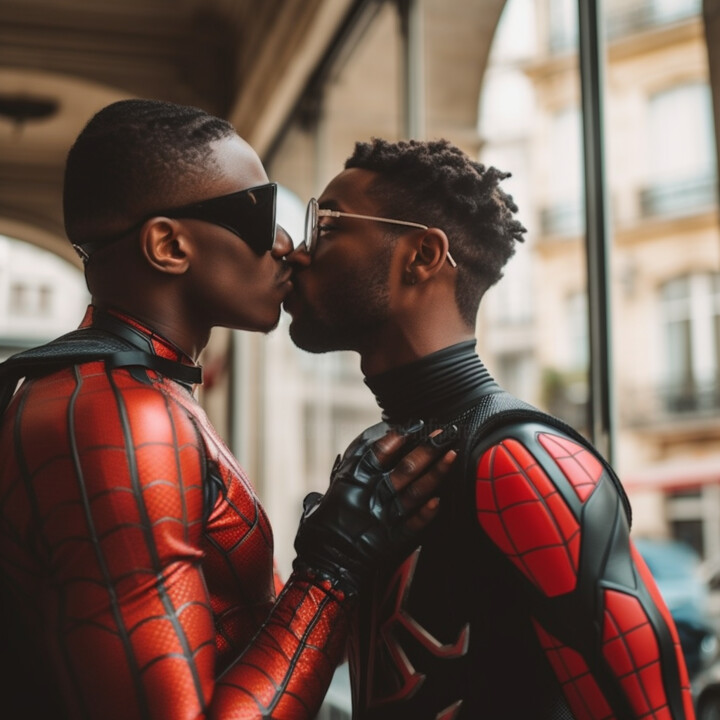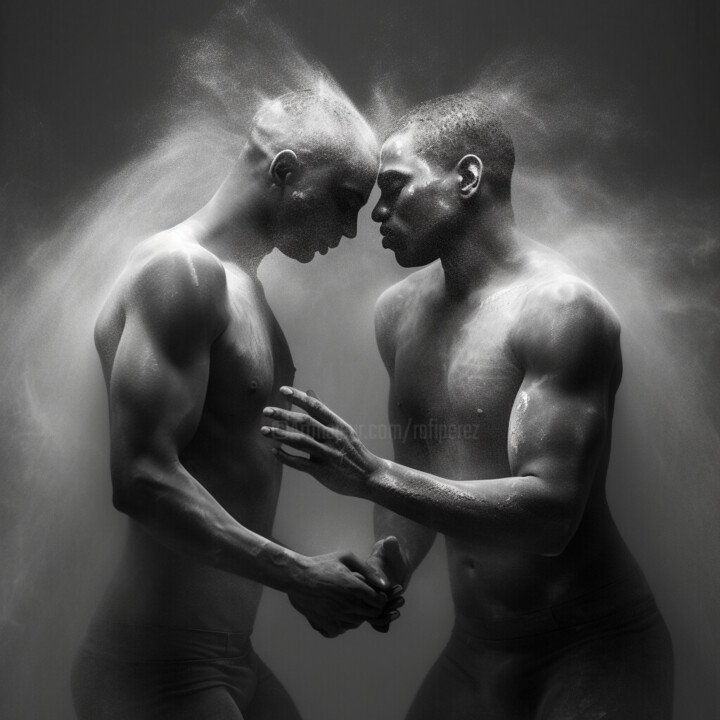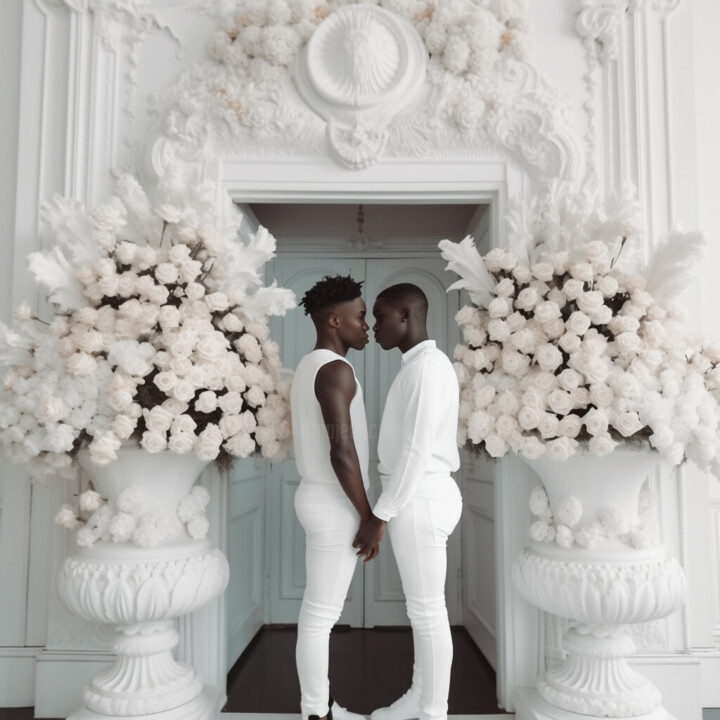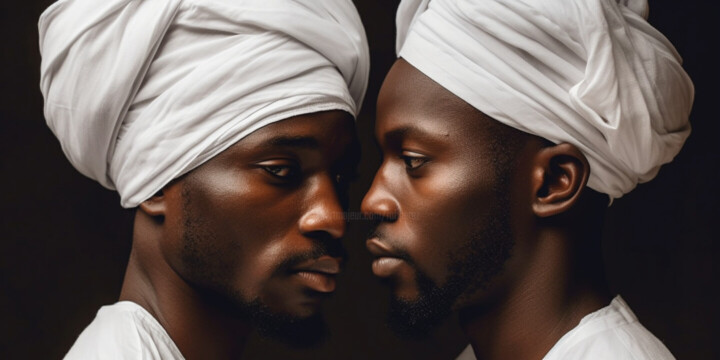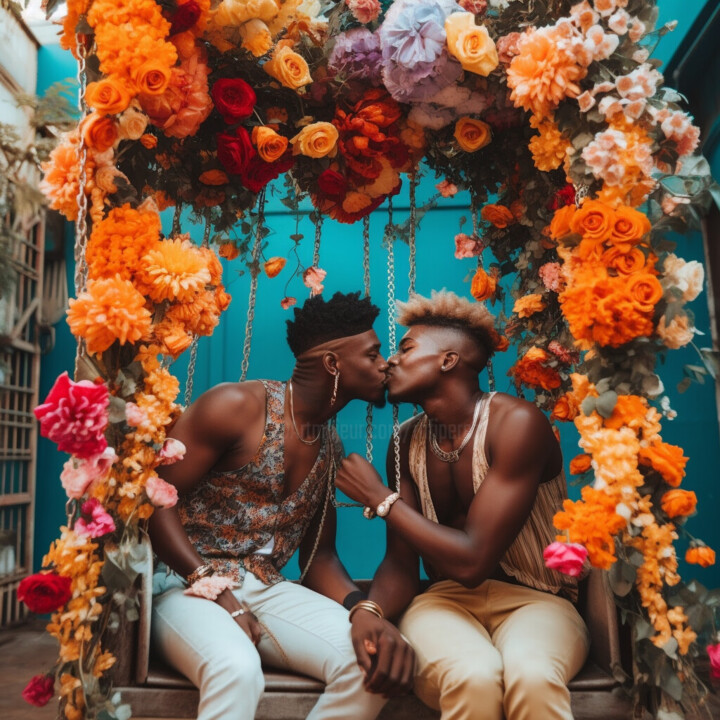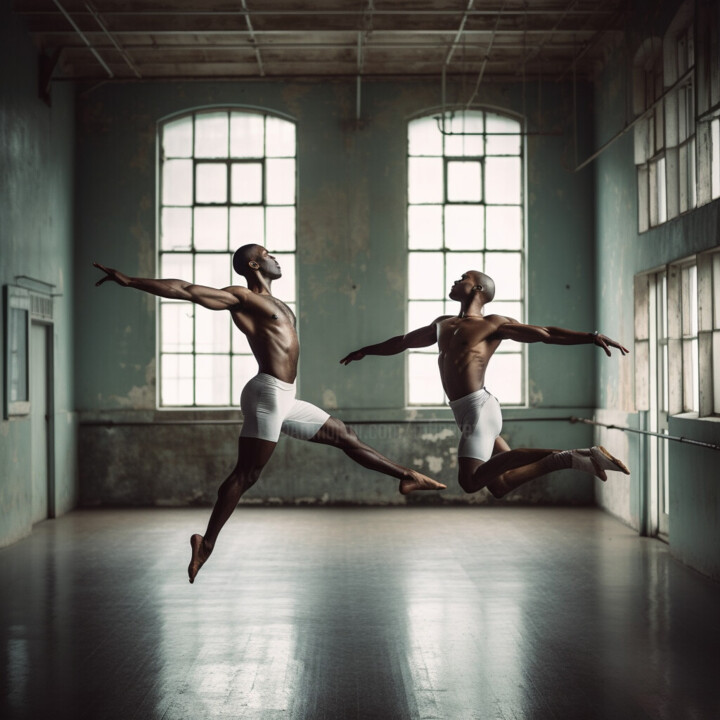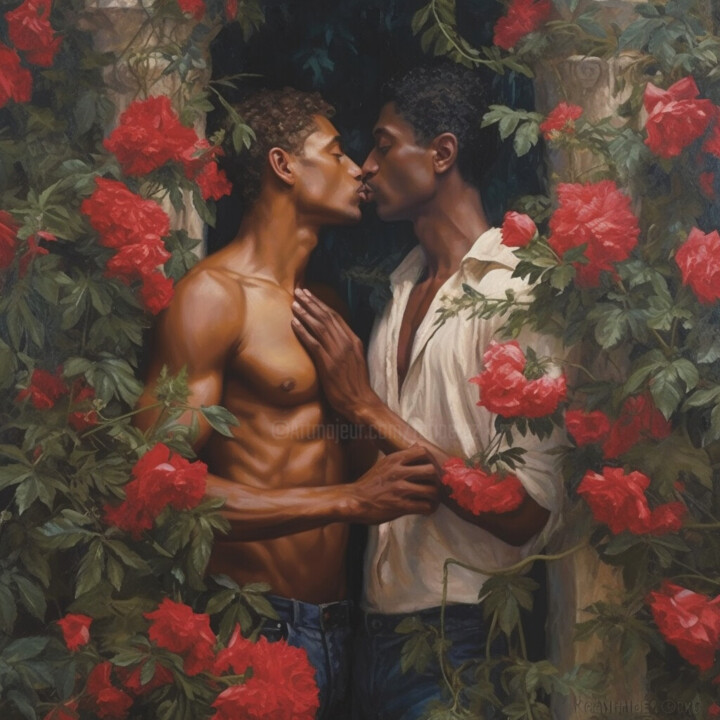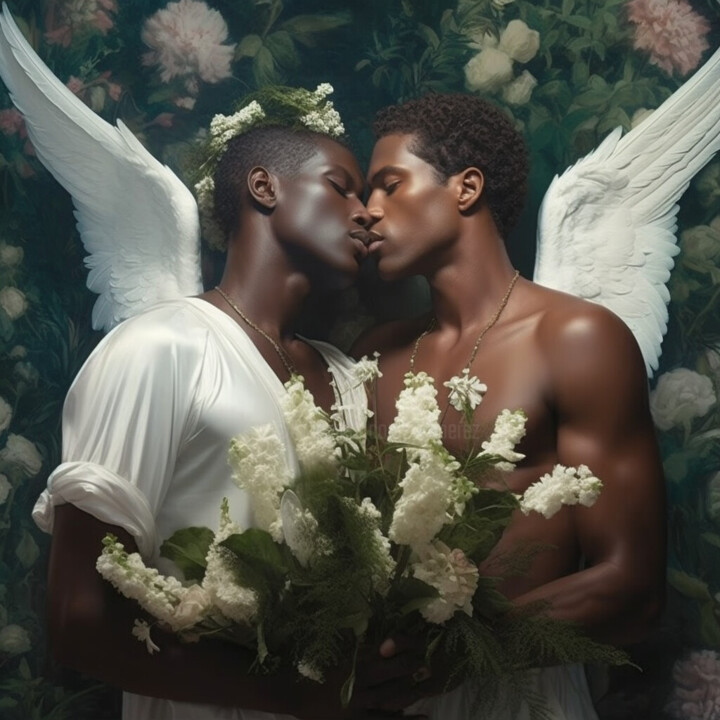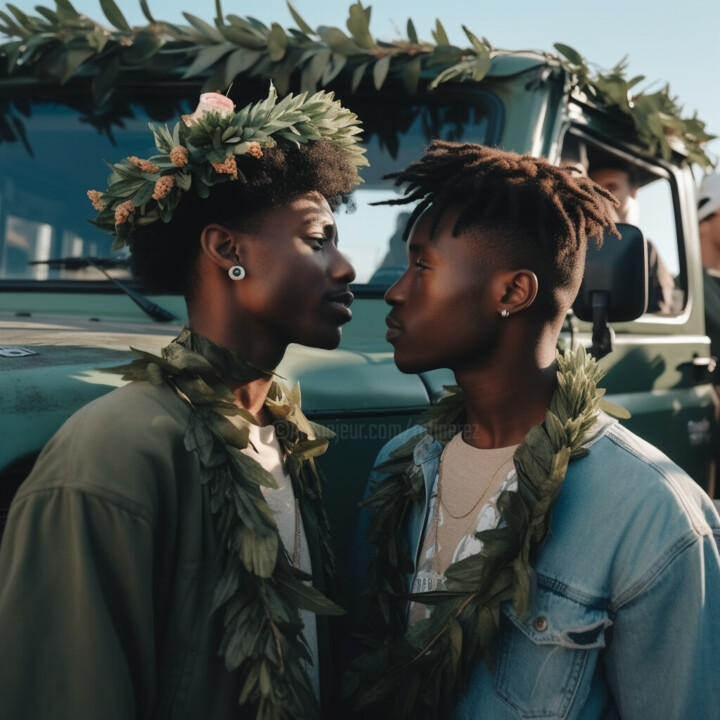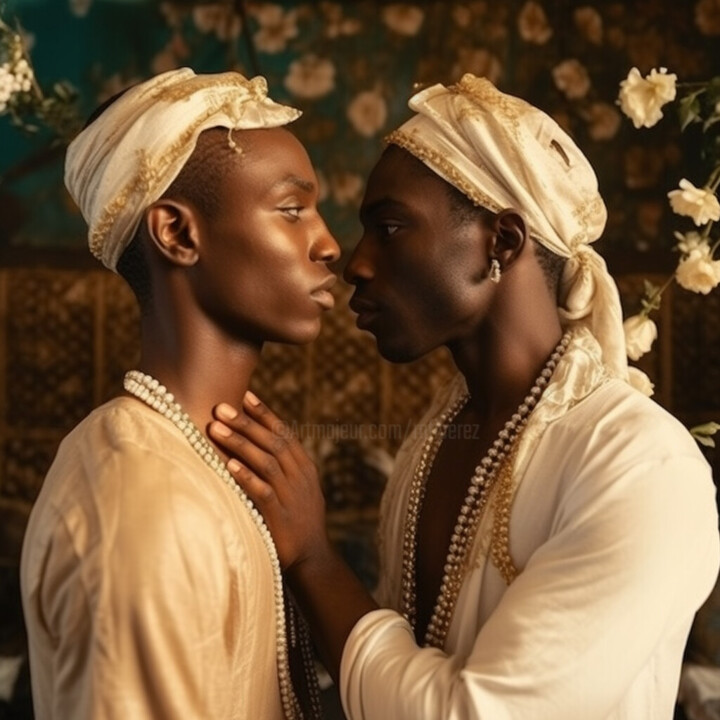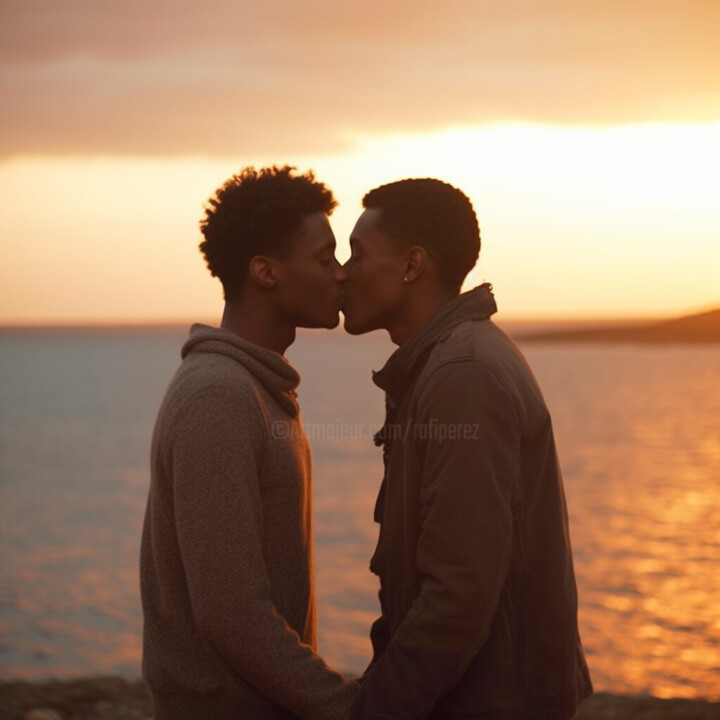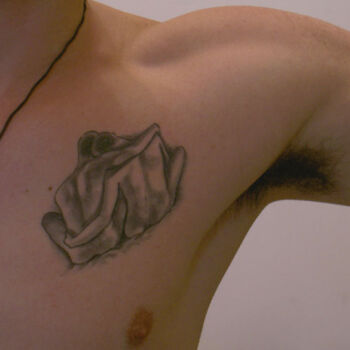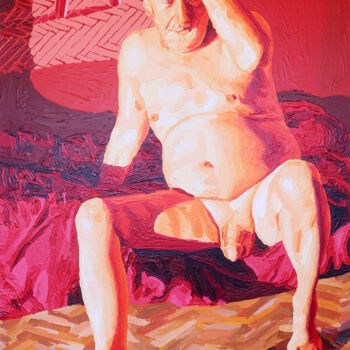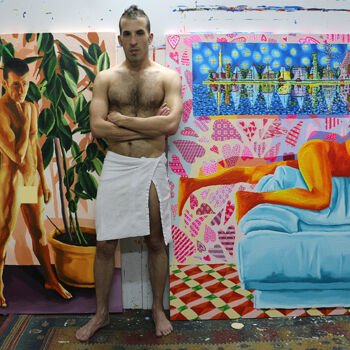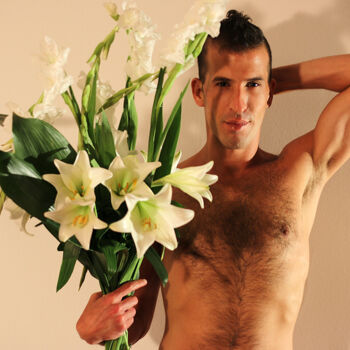deux hommes noir couple homosexuel photo amour baiser (2023) 디지털 아트 Raphael Perez 로
이 이미지는 라이선스로 다운로드할 수 있습니다.
Raphael Perez 에서 판매
-
이 작품은 "오픈 에디션"입니다
디지털 아트,
지클레 프린트 / 디지털 인쇄
- 치수 여러 크기 사용 가능
- 여러 지원 가능 (미술용지, 메탈 프린트, 캔버스 프린트)
- 프레이밍 프레임 사용 가능 (플로팅 프레임 + 유리 아래, 프레임 + 아크릴 유리 아래)
- 작품의 상태 작품은 완벽한 상태입니다
- AI 생성 이미지 작가는 인공지능 기술을 이용해 이 이미지를 만들었다.
- 카테고리 조형 미술 사랑 / 로맨스
Que signifie aimer quelqu'un qui vous ressemble, qui partage votre identité, qui comprend vos luttes ? Que signifie aimer quelqu’un qui est opprimé par le même système qui vous opprime, qui fait face aux mêmes dangers et préjugés que vous ? Que signifie aimer quelqu’un de noir et d’homosexuel ?
Telles sont quelques-unes des questions que peut évoquer une photo d’amour entre deux jeunes hommes noirs. Les photos, réalisées par intelligence artificielle, capturent un moment de tendresse entre deux amants, qui se regardent dans les yeux avec affection et intimité. Leurs expressions sont sereines et confiantes, comme s'ils avaient trouvé un refuge dans les bras l'un de l'autre. Leurs carnations contrastent et se complètent, créant une harmonie de nuances et de textures. Leurs coiffures reflètent leur individualité et leur personnalité, tout en les reliant à leurs racines culturelles. Leurs vêtements sont décontractés et confortables, suggérant un sentiment d'aisance et de familiarité.
L’image est une représentation puissante de la romance queer noire, qui est souvent invisible ou marginalisée dans les médias grand public et dans la société. L’homosexualité des Noirs a toujours été confrontée à de multiples formes d’oppression et de discrimination, tant au sein qu’à l’extérieur de leurs communautés. Ils ont été effacés de l’histoire, diabolisés par la religion, criminalisés par la loi, stigmatisés par les soins de santé, stéréotypés par la culture et ciblés par la violence. Ils ont également été exclus des récits dominants d’amour et de romance, qui tendent à privilégier les couples blancs, hétérosexuels et cisgenres.
Cependant, malgré ces défis et obstacles, les personnes queer noires ont toujours trouvé le moyen d’aimer et d’être aimées. Ils ont créé leurs propres espaces et communautés, où ils peuvent exprimer librement leur identité et leurs désirs. Ils ont développé leurs propres formes d’art et d’activisme, où ils peuvent célébrer leur beauté et leur résilience. Ils ont forgé leurs propres liens et relations, dans lesquels ils peuvent se soutenir et se nourrir mutuellement.
L’image de l’amour entre deux jeunes hommes noirs est un témoignage de cette histoire et de la réalité de l’amour des gays noirs. Il ne s’agit pas seulement d’un portrait personnel de deux individus, mais aussi d’une déclaration collective de fierté et de résistance. Il remet en question les stéréotypes et les préjugés qui dévalorisent et déshumanisent les personnes lgbtq noires. Il affirme la dignité et l’humanité des personnes LGBT noires. Il met en valeur la diversité et la complexité des personnes queers noires. Il honore l’héritage et le potentiel des personnes queer noires.
Les images nous invitent également à réfléchir sur les aspects psychologiques, philosophiques et culturels de l'amour entre deux jeunes homosexuels issus de la communauté lgbt noire. Comment font-ils face au stress et aux traumatismes auxquels ils peuvent être confrontés dans leur vie quotidienne ? Comment parviennent-ils à concilier leurs besoins et attentes personnels avec leurs rôles et responsabilités sociales ? Comment naviguent-ils dans leurs multiples identités et intersections ? Comment communiquent-ils leurs sentiments et leurs émotions ? Comment gèrent-ils les conflits et les désaccords ? Comment grandissent-ils et évoluent-ils ensemble ?
Telles sont quelques-unes des questions que peut inspirer une photographie d’amour entre deux jeunes hommes noirs. L'œuvre d'art n'apporte pas de réponses définitives, mais ouvre plutôt des possibilités de dialogue et d'exploration. Il nous invite à écouter leurs histoires, à comprendre leurs points de vue, à sympathiser avec leurs expériences. Elle nous invite à apprécier leurs joies, à partager leurs peines, à célébrer leurs réalisations. Elle nous invite à reconnaître leurs similitudes, à respecter leurs différences, à embrasser leur diversité.
Les œuvres d’amour entre deux jeunes hommes afro-américains sont un cadeau rare et précieux. C'est un aperçu d'un monde souvent caché ou ignoré. C’est un rappel que l’amour est universel et diversifié. C'est l'espoir que l'amour puisse vaincre la haine et la peur. C'est une vision selon laquelle l'amour peut transformer les vies et les sociétés.
Foto Cinta: Menjelajahi Makna Black Queer Romance
Apa artinya mencintai seseorang yang mirip dengan Anda, yang memiliki identitas yang sama dengan Anda, yang memahami perjuangan Anda? Apa artinya mencintai seseorang yang tertindas oleh sistem yang sama yang menindas Anda, yang menghadapi bahaya dan prasangka yang sama seperti Anda? Apa artinya mencintai seseorang yang berkulit hitam dan gay?
Inilah beberapa pertanyaan yang dapat ditimbulkan oleh foto penuh kasih antara dua pemuda kulit hitam. Foto-foto tersebut, yang diambil dengan kecerdasan buatan, mengabadikan momen mesra antara dua kekasih, yang saling menatap mata dengan kasih sayang dan keintiman. Ekspresi mereka tenang dan percaya diri, seolah-olah mereka telah menemukan perlindungan dalam pelukan satu sama lain. Warna kulit mereka kontras dan saling melengkapi, menciptakan harmoni corak dan tekstur. Gaya rambut mereka mencerminkan individualitas dan kepribadian mereka, sekaligus menghubungkan mereka dengan akar budaya mereka. Pakaian mereka kasual dan nyaman, menunjukkan rasa nyaman dan keakraban.
Gambar tersebut merupakan representasi kuat dari romansa queer kulit hitam, yang seringkali tidak terlihat atau terpinggirkan di media arus utama dan masyarakat. Homoseksualitas kulit hitam selalu menghadapi berbagai bentuk penindasan dan diskriminasi, baik di dalam maupun di luar komunitasnya. Mereka telah terhapus dari sejarah, dibenci oleh agama, dikriminalisasi oleh hukum, distigmatisasi oleh layanan kesehatan, distereotipkan oleh budaya, dan menjadi sasaran kekerasan. Mereka juga dikecualikan dari narasi dominan tentang cinta dan romansa, yang cenderung mengistimewakan pasangan berkulit putih, heteroseksual, dan cisgender.
Namun, terlepas dari tantangan dan hambatan ini, kaum queer kulit hitam selalu menemukan cara untuk mencintai dan dicintai. Mereka telah menciptakan ruang dan komunitasnya sendiri, di mana mereka dapat dengan bebas mengekspresikan identitas dan keinginannya. Mereka telah mengembangkan bentuk seni dan aktivisme mereka sendiri, di mana mereka dapat merayakan keindahan dan ketahanan mereka. Mereka telah menjalin ikatan dan hubungan mereka sendiri, di mana mereka dapat saling mendukung dan memelihara.
Gambaran cinta antara dua pemuda kulit hitam adalah kesaksian sejarah dan realitas cinta gay kulit hitam. Ini bukan hanya potret pribadi dua individu, tetapi juga pernyataan kebanggaan dan perlawanan kolektif. Ini menantang stereotip dan prasangka yang merendahkan dan tidak memanusiakan kelompok LGBTQ kulit hitam. Hal ini menegaskan martabat dan kemanusiaan kelompok LGBT berkulit hitam. Ini menyoroti keragaman dan kompleksitas kaum queer kulit hitam. Ini menghormati warisan dan potensi kaum queer kulit hitam.
Gambar-gambar tersebut juga mengajak kita untuk merefleksikan aspek psikologis, filosofis dan budaya dari cinta antara dua pemuda homoseksual dari komunitas LGBT kulit hitam. Bagaimana mereka mengatasi stres dan trauma yang mungkin mereka hadapi dalam kehidupan sehari-hari? Bagaimana mereka berhasil menyelaraskan kebutuhan dan harapan pribadi mereka dengan peran dan tanggung jawab sosial mereka? Bagaimana mereka menavigasi berbagai identitas dan persimpangan mereka? Bagaimana mereka mengomunikasikan perasaan dan emosi mereka? Bagaimana mereka menangani konflik dan perselisihan? Bagaimana mereka tumbuh dan berkembang bersama?
Itulah beberapa pertanyaan yang bisa menginspirasi sebuah foto cinta antara dua pemuda kulit hitam. Karya seni tersebut tidak memberikan jawaban pasti, melainkan membuka kemungkinan dialog dan eksplorasi. Hal ini mengundang kita untuk mendengarkan cerita mereka, memahami sudut pandang mereka, dan berempati dengan pengalaman mereka. Beliau mengajak kita untuk mengapresiasi kegembiraan mereka, berbagi kesedihan, merayakan pencapaian mereka. Hal ini mengajak kita untuk mengenali persamaan mereka, menghormati perbedaan mereka, dan merangkul keberagaman mereka.
Karya cinta antara dua pemuda Afrika-Amerika adalah hadiah langka dan berharga. Ini adalah gambaran sekilas tentang dunia yang sering disembunyikan atau diabaikan. Ini adalah pengingat bahwa cinta itu universal dan beragam. Harapannya cinta bisa mengalahkan kebencian dan ketakutan. Ini adalah visi bahwa cinta dapat mengubah kehidupan dan masyarakat.
관련 테마
Raphael perez Hebrew name rafi peretz was born into a traditional family and grew up in Jerusalem.
Family biography Raphael Perez father, Shimon Perez, worked as a receptionist at Hadassah Ein Kerem Hospital in Jerusalem. His great love was art, but as a breadwinner, he could not fulfill his dream of becoming an artist. Raphael’s mother, Alice Aliza Perez, worked as an assistant to a kindergarten teacher and later took care of a baby at home. She loved gardening and nature, and together with her husband, created a magnificent garden.
Raphael has several siblings. His elder brother David Perez repented in his mid-twenties and brought many people back to repentance. His sister Hana Peretz raised eight children and worked in the field of education. His brother Avi (Abraham) Peretz studied Philosophy and Judaism in Israel before moving to the United States where he completed his master’s degree in education and became a conservative rabbi. His fourth brother is Asher Peretz, who is very fond of traveling and has been to magical places all over the world. Raphael is the fifth sibling and has a twin brother named Miki (Michael) Peretz, who is a talented industrial designer. The youngest sibling is Shlomit Peretz, who has been involved in the Bezeq telephone company for almost three decades.
Peretz). In the IDF, he served in the Artillery Corps. He worked for 15 years in education in therapeutic settings for children and taught art and movement.
Peretz is a graduate of the Center for Visual Arts in Be'er Sheva, where he studied from 1989-1992. He has been painting since 1989 and since 1999 earns a living only from selling art. Since 1995 he has lived and worked from his studio in Tel Aviv.
Between the ages of 17 and 32, he wrote about forty diaries, sketchbooks and artist books in which he wrote daily and described his thoughts, experiences and feelings and his struggle with his homosexual sexual orientations. He later adorned the diaries with illustrations and drawings. The diaries were presented in a solo exhibition at Camera Obscura and in a group exhibition at the Sommer Gallery.
In his work, starting in 1995, he dealt with relationships, initially with relationships between men and women, in which complex relationships between men and women can be seen. In addition to explicit paintings, he created series of flower paintings, as a metaphor for the relationship between a man and a woman.
At the age of 32 he came out of the closet and began to draw relationships between men. At first, the paintings express hesitation and imperfection, while Peretz does not reveal the faces of the cartoonists. After his first love for a man in 1999 and coming to terms with his sexual orientation, the paintings became peaceful and he presented the homosexual relationship in an ideal way. Peretz has created a series of naive paintings that deal with loving relationships between men and common daily activities in the home environment. Over the years he painted his mates.
-
국적:
이스라엘

- 생년월일 : 1965
- 예술적 영역:
- 여러 떼: 현대 이스라엘 예술가

